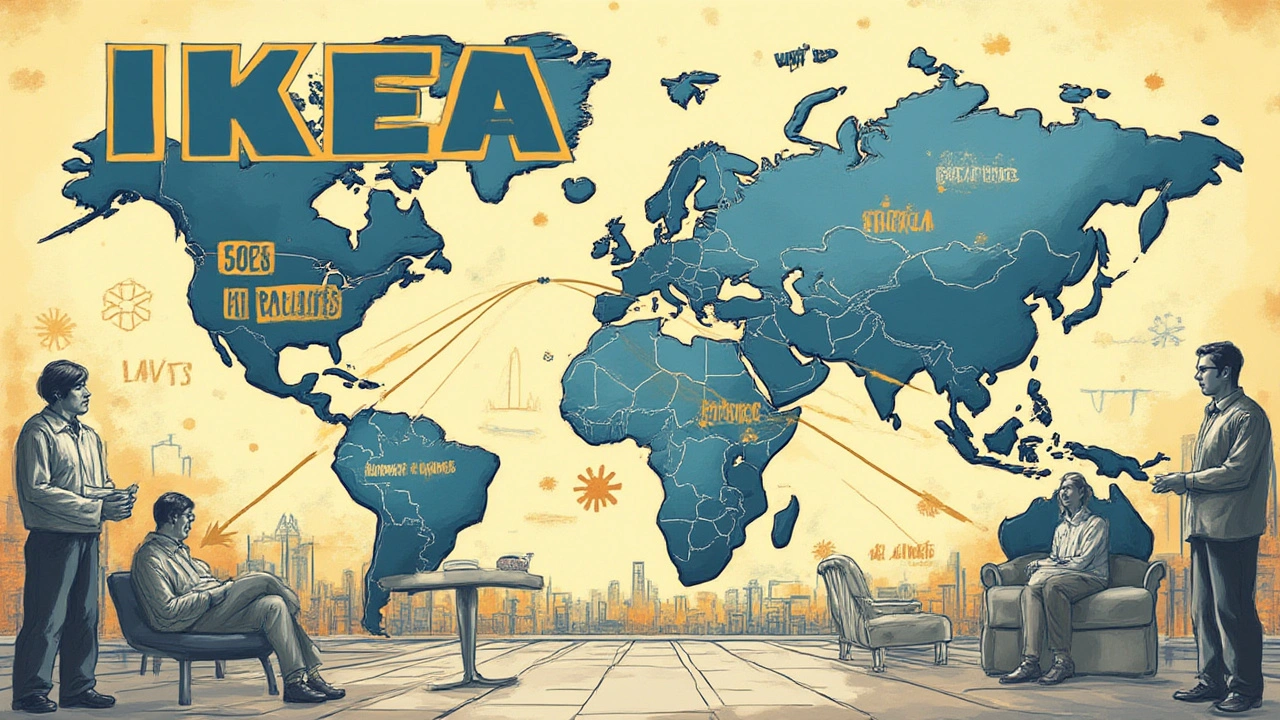Everyone’s had an IKEA bookshelf. Most of us have cursed at one of those cryptic picture instructions or felt smug after slotting that last wooden peg into place. Here’s a secret: there’s a reason it feels like everyone owns at least one piece of IKEA furniture. The truth is, you’d have to search far and wide to find a company that sells more furniture than this Swedish giant. If you think a luxury brand or an American retail behemoth is the world's biggest furniture seller, prepare for a surprise. The blue and yellow logo isn't just famous—it's unstoppable. Yet, how did IKEA clinch this spot, and is anyone close to knocking them off their pine-and-particleboard throne in 2025?
The Secret to IKEA's Global Furniture Reign
If you walk into an IKEA, you’re also wandering through the top-selling furniture company on Earth. IKEA’s held onto this title for years, moving an estimated €47 billion (about $50 billion) in sales globally for fiscal 2024, according to its parent company Ingka Group’s annual report. The next closest dedicated furniture sellers trail by billions. IKEA isn't just on top—it's in its own league.
What’s their secret recipe? Start with flat-pack design. By cramming beds, shelves, and even full kitchens into little boxes, IKEA saves on shipping, storage, and gives you—yes, you, my friend—the gift (or curse) of self-assembly. It’s no accident. Back in the 1950s, founder Ingvar Kamprad watched an employee remove the legs of a coffee table so it’d fit in his car. Boom: a legend was born.
Then there’s scale. With over 460 stores sprawled across more than 60 countries, IKEA doesn’t just serve up meatballs in every major city (seriously, about a billion meatballs sold each year), it ships more Billy bookcases than some whole countries make actual books. It also wins on price, with massive production runs and tight cost control. You see those low price tags? Not an accident. Every unnecessary bolt, fancy finish, or bit of packaging gets the axe if it lets IKEA trim a few cents.
The last puzzle piece: design. IKEA’s team studies how people in tiny apartments in Tokyo or big homes in Houston live. They test hundreds of furniture styles and sizes. The result? Products like the KLIPPAN sofa or MALM bed fit a wild range of tastes and room sizes. The company even retools products to make them easier to reuse, recycle, or slot into a new room layout.
The secret, in the end, isn’t exactly a secret: it’s relentless simplicity, huge scale, and taking inspiration from everywhere. You don’t get to be the world’s top seller of furniture by luck—or by just handing out free Allen wrenches.
IKEA in Numbers: Sales, Stores, and Growth
Let’s talk data. Because, as dry as numbers sometimes sound, they reveal why IKEA is so far ahead of the pack. Here’s a quick look:
| Company | Annual Furniture Sales (2024) | Number of Stores | Countries Present |
|---|---|---|---|
| IKEA | €47 billion (~$50 billion) | 460+ | 60+ |
| Ashley Furniture | $6.5 billion | 1,000+ | 60+ |
| Wayfair | $12.1 billion | Online only | 20+ |
| La-Z-Boy | $2.4 billion | 350+ | 2+ |
| Herman Miller (MillerKnoll) | $3.2 billion | 100+ | 12+ |
See that gap? No one’s close. Even online-only giants like Wayfair still chase IKEA’s numbers, despite a massive digital presence.
But here’s the twist: IKEA isn’t just growing because people want cheap dressers. They’re shifting more sales online than ever, with ecommerce carrying nearly 30% of total orders as of 2024. Some countries, like China and the UK, are seeing double-digit growth in digital orders every year. IKEA’s even investing billions into new formats: small city-center shops in Manhattan, Paris, and Mumbai, and a huge push in India, which will be the third largest market by sales by 2026 if trends continue.
Beyond sales, IKEA draws eye-popping numbers for foot traffic—with about 770 million store visits per year pre-pandemic, and digital traffic well over 4 billion visits annually. No other furniture name blends physical and digital reach quite like this.

Why IKEA Sells So Much: Relatable Design, Price, and a Bit of DIY
Get this: the most-sold furniture item in the world is likely IKEA’s BILLY bookcase. Over 60 million have sold since 1979. If you stacked them end to end, you’d circle the planet. But IKEA’s success isn’t just about quirky product names or those pocket-sized pencils.
First—it’s affordability. IKEA pinches pennies in surprising places. They’ll trim packaging weight, use recycled materials (about 70% of wood is sourced from sustainable forestry), and design each piece so it packs flat. These little cost savings add up, and the savings get passed on to you at the checkout.
Second—functionality. The company invests in research to learn how people live, eat, relax, and store things in real homes. That’s how you get clever under-bed storage options, extendable tables, and couches that fit into tiny apartments. IKEA adapts fast, too: during lockdowns, they launched tons of home-office-friendly designs, and they haven’t looked back.
Third—the experience. Shopping at IKEA is weirdly addictive. You follow that maze-like path, and by the time you get to the market hall, you’ve filled your cart, eaten meatballs, and “accidentally” adopted a pack of tealight candles. It works. Stores blend showroom inspiration with a warehouse vibe—you can picture yourself living in the display room, then grab the box and haul it home.
Lastly, there’s real investment in sustainability. IKEA’s even growing mushrooms that eat polystyrene as a plastic-free packing alternative. The company aims for climate positivity by 2030 and wants all its products to be made from renewable or recycled materials. Prices stay low, but the company’s green efforts give it a boost with younger shoppers. That sells furniture—and loyalty.
Rising Competitors and What the Future Holds
Does anyone stand a chance? Well, IKEA dominates, but the chase is on. In the United States, Ashley HomeStore claims over a thousand stores worldwide and keeps snapping up customers with aggressive expansion. In China, brands like Red Star Macalline run mega-malls stuffed with local and international furniture, and their annual sales hover around $8 billion.
Digital players matter more every year. Wayfair, now raking in over $12 billion, has become a household name for online furniture and decor. While it still lags behind IKEA in scale (and lacks those magical in-store meatballs), Wayfair’s model is all about endless choice and fast delivery. That ticks the right boxes for city customers, though they miss out on plopping down on a couch before buying it.
Amazon sells piles of furniture too, but it’s not a dedicated furniture store—it’s a mega-mall for everything, including Oliver’s dog bed and Willow’s fancy litter box. In Europe, companies like Steinhoff and Grupo Pão de Açúcar try to bite off a chunk, but they’re patchwork companies with mixed retail lines.
A few wildcards might surprise you. India is booming, with homegrown companies like Pepperfry and UrbanLadder, plus IKEA aiming to open 40 new India stores by 2030. Africa and Southeast Asia also have giant new middle classes fueling local upstarts, but IKEA’s aggressive investment means it’ll likely stay on top—at least for the next few years.
The biggest threat to IKEA may be the way we buy furniture itself. Gen Z and Millennials shop more online and care more about fast delivery, modular design, and eco-credentials. IKEA’s already responding—tighter online shopping, rental programs, repair parts, and a buyback system where you can return old shelves and get store credit.
One tip if you want to get ahead of the curve: watch for “re-commerce” platforms. These are booming in Europe and North America, where folks sell secondhand IKEA furniture through official or partner apps. It’s perfect for anyone moving, upgrading, or just tired of hex wrenches coming loose in the couch cushions.
Bottom line: largest furniture seller in the world? That’s IKEA, by a Swedish mile. But if you’re eyeing trends—check out how fast online sales, eco-friendly furniture, and even virtual shopping are moving. The next time you’re cursing those impossible instructions, remember: you’re taking part in a global tradition that’s showing no sign of stopping.


Kate Tran
July 18, 2025 AT 02:53IKEA's global presence is truly impressive. Their ability to combine affordability with a decent level of design makes them stand out. Plus, their flat-pack concept is genius—it allows them to save on shipping and pass the savings to customers.
I think what also helps IKEA is their knack for understanding regional preferences and adjusting product lines accordingly. Although they lead now, it’s interesting to see rivals starting to catch up with innovations in materials and sustainability.
Does anyone know which other companies are gaining ground quickly? Are there any emerging markets where local brands pose a real challenge to IKEA?
Patrick Bass
July 18, 2025 AT 03:53Great points about IKEA's logistics and regional adaptations. What I find interesting is how IKEA's catalog combines simplicity with the Scandinavian aesthetic, which appeals worldwide. It's not just affordable furniture; it's often perceived as a lifestyle choice.
I wonder how much their online sales contribute to their dominance compared to brick-and-mortar stores, especially post-pandemic. Other companies could be focusing on e-commerce strategies to challenge them.
Has anyone seen data comparing online vs physical store sales for furniture companies globally?
Tamil selvan
July 18, 2025 AT 04:53Indeed, the growth in e-commerce is something we can't overlook when discussing furniture sales. IKEA's website and app enhancements have definitely captured a wider audience, including younger shoppers who prefer digital-first experiences.
Besides, I appreciate how IKEA has been pushing sustainable practices, which aligns well with current consumer values. Offering eco-friendly products and materials might be a key factor helping them maintain a competitive edge.
Perhaps rivals need to invest more in sustainability and digital transformation to close the gap.
saravana kumar
July 18, 2025 AT 05:53Honestly, when we talk about furniture, IKEA is often overhyped. Sure, they sell a lot, but the quality often leaves much to be desired. Many of their products don’t last long, which is typical of mass-market, cheap furniture. It's a trade-off, but one I see as a flaw in their dominance.
Many emerging rivals, especially luxury or bespoke furniture makers, play in a different ballgame. They cater to clientele that want craftsmanship and durability, not just quantity and convenience. The question remains whether these rivals will ever truly challenge IKEA's global sales volume.
Still, IKEA's brand is the king of the volume game, no doubt.
amber hopman
July 18, 2025 AT 06:53While I agree about the variable quality, I would say IKEA has reinvented what furniture buying looks like for a huge chunk of people worldwide. It’s not just about buying a chair or table; it’s about having accessible design and sustainable options.
But I’m also curious about the rise of rivals—companies that might focus on quality without losing affordability. Are they growing fast? Or do they remain niche competitors?
Also, regional tastes must influence this – local brands might be invisible globally, but dominate in their specific markets.
Mark Brantner
July 18, 2025 AT 07:53Okayyy, so IKEA is the king of flat-pack castles, no doubt. But honestly, can we talk about how bloopersome putting together their stuff is? Like why do I always end up with extra screws and a chair that kinda wobbles? Lol.
But jokes apart, they dominate because they make furniture that’s cheap, look decent, and everyone everywhere can ship it cheaply. Rivals gotta step up their game if they want to beat that kind of logistics magic.
Anyone else build a furniture piece and wanted to throw it out the window? Or is it just me being hopeless?
Jim Sonntag
July 18, 2025 AT 08:53This is hilarious, but so relatable! Flat-pack furniture should probably come with a professional assembly service included for free, considering the disaster zone it often creates in my living room.
On a serious note, IKEA’s scalability is unmatched. Their supply chain efficiency puts most competitors to shame, and that's a big part of their ability to sell more furniture worldwide.
Still, it’d be interesting to see if newer rivals are innovating in areas where IKEA falls short—like customization or premium quality materials.
Deepak Sungra
July 18, 2025 AT 09:53It’s fascinating how people either really love or really hate IKEA’s furniture and strategies. Personally, I think their dominance is driven largely by marketing hype and convenience rather than true innovation.
Sure, there are rising competitors, especially from Asia, that focus on higher craftsmanship and even tech integration in furniture. But IKEA’s sheer scale and sunk cost advantages make them tough to beat anytime soon.
Also, you gotta admit their minimalist style defines modern living rooms almost everywhere. That alone secures them a stronghold in the market.
Samar Omar
July 18, 2025 AT 10:53Ahh, but the aesthetic appeal is what truly cements IKEA’s reign. Their style, although maybe branded as 'minimalist Scandinavian,' has become a cultural phenomenon. It’s not just furniture; it’s a statement about modernity and lifestyle that resonates globally.
The thought that other companies can effortlessly usurp this throne ignores the emotional and cultural attachment many have to IKEA’s brand.
That being said, luxury and bespoke furniture brands will always occupy a separate niche, distinct from IKEA’s massive market.
Still, I wonder if an emerging brand with the right marketing and innovation could disrupt this status quo? Would love to hear thoughts.
chioma okwara
July 18, 2025 AT 11:53Well, as someone who’s nitpicky about grammar and presentation, I should say this post is a decent intro without too many errors, but it barely scratches the surface. When discussing the biggest furniture sellers, we need to consider not just sales volume but also aftersales service, durability, and customer satisfaction metrics.
Moreover, IKEA's massive global sales don’t always translate to the best customer experience. Many users complain about product longevity, as others have mentioned. Rivals catching up must focus on these softer factors to really challenge IKEA’s dominance.
Anyone here had personal experiences with quality differences between IKEA and others?